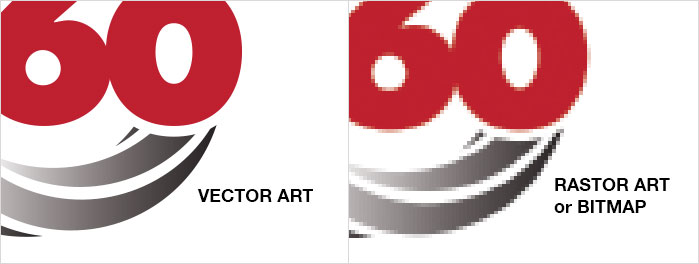I’m new to working with graphic designers. What do all the file extensions mean?
As graphic designers we are required to navigate the sea of file formats to determine the best one for the job. There are many file formats, and if you are new to working with designers, they can be very confusing. Allow us to help. Here we’ve put together a list of some of the most important file formats you will come across in your day-to-day marketing efforts. This is not a complete list, but these are the most common and most universal.
First things first. You need to know the difference between “vector” art and “raster” art.
Vector Art
Vector art is the term used to describe a file created using outlines, paths or strokes. If properly created, vector files can be enlarged or reduced to any size with no loss of resolution. Your logo will look great on a business card or on a billboard. Most commonly, vector art is created using the industry standard software Adobe Illustrator.
Raster Art or Bitmap
In contrast to vector art, Raster Art or Bitmap files are made up of pixels (tiny blocks of information). There is a finite amount of information in raster files, which is determined at the beginning of the file’s creation. This is where resolution comes into play. For commercial printing purposes your art should be at least 300 dpi (dots per inch) at 100% of size, or 72 dpi for web. If your art is short of this mark, you may need to rescan or recreate your art so it meets the minimum, or risk having a blurry, pixelated final product. Photographs and documents created in Adobe Photoshop are raster files.

Now that you have a bit (Get it? “…a bit…”) of background, on to the list.
EPS = Encapsulated Post Script (.eps)
Vector art. Most often created from Adobe Illustrator. Great for logos, large format printing, or items that need to be shown at many sizes without loss of resolution.
AI = Adobe Illustrator (.ai)
Vector art. This is the native format for Illustrator files. Very similar to EPS.
TIFF = Tagged Image File Format (.tif or .tiff)
Best format for high-resolution imagery or photos when being used in commercial printing applications. Large file size makes them difficult to successfully email. This is a raster file type.
PSD = Photoshop Document (.psd)
Raster art. This is the native format for Adobe Photoshop files. You can, however, also create EPS files and outlines in Photoshop.
JPEG = Joint Photographic Experts Group (.jpg or .jpeg)
Raster art. This is the format of most photos. Generally ok for printing, with smaller file size. Good for photos displayed online. Watch for conflicts when converted to CMYK from RGB.
GIF = Graphics Interchange Format (.gif)
Raster art. Quickly being replaced by PNG. Good for internet graphics which are NOT photos. Photos should be shown online as JPEG’s or PNG’s.
PDF = Portable Document Format (.pdf)
Good for printing and emailing, small file size, excellent for documents with multiple pages. Quickly becoming an industry standard for printing documents.
PNG = Portable Network Graphics (.png)
Raster or bitmap. Another good file type for internet graphics and photos. Created as a higher quality replacement for GIF. Allows for crisper images and accurate transparent effects.
We hope this becomes your go-to guide for file format basics. Armed with this knowledge, you can most certainly navigate through a large majority of print and web graphics projects.